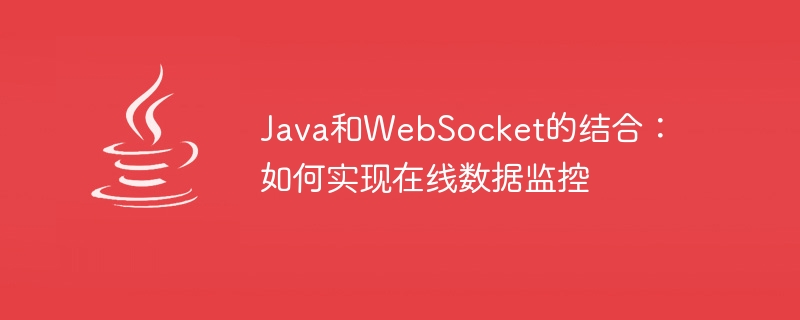Home >Java >javaTutorial >The combination of Java and WebSocket: how to implement online data monitoring
The combination of Java and WebSocket: how to implement online data monitoring
- WBOYWBOYWBOYWBOYWBOYWBOYWBOYWBOYWBOYWBOYWBOYWBOYWBOriginal
- 2023-12-18 10:07:401287browse

The combination of Java and WebSocket: how to implement online data monitoring
Introduction:
With the rapid development of the Internet, real-time monitoring of data has become more and more important. In many real-time monitoring scenarios, using Java combined with WebSocket technology can quickly build a real-time data monitoring system. This article will introduce the basic concepts of WebSocket and explain how to use Java and WebSocket to implement online data monitoring through specific code examples.
1. Introduction to WebSocket:
WebSocket is a new protocol that emerged in HTML5. It realizes full-duplex communication between the browser and the server. Compared with traditional HTTP-based Ajax polling, WebSocket can achieve real-time, efficient, and two-way data transmission, and is especially suitable for online data monitoring scenarios.
2. WebSocket implementation in Java:
Java provides a variety of WebSocket implementation libraries, among which the more commonly used ones are javax.websocket and Spring WebSocket. This article will use javax.websocket as an example to introduce the WebSocket implementation in Java.
- Environment configuration:
First you need to ensure that the javax.websocket library has been installed in the Java environment. Dependent libraries can be added to the project through build tools such as Maven. - WebSocket server-side implementation:
The following is a simple WebSocket server-side implementation example:
import javax.websocket.OnClose;
import javax.websocket.OnMessage;
import javax.websocket.Session;
import javax.websocket.server.ServerEndpoint;
@ServerEndpoint("/websocketServer")
public class WebSocketServer {
@OnMessage
public void onMessage(String message, Session session) {
// 处理收到的消息
System.out.println("Received message: " + message);
// 发送消息给客户端
session.getBasicRemote().sendText("Hello, client!");
}
@OnClose
public void onClose(Session session) {
// WebSocket关闭时执行的操作
System.out.println("WebSocket closed");
}
}In the above code, the @ServerEndpoint annotation defines the endpoint address of WebSocket, the client The client can establish a connection with the server through this address. The @OnMessage annotation is used to handle received messages, and the @OnClose annotation is used to handle WebSocket closing events.
- WebSocket client-side implementation:
The following is a simple WebSocket client-side implementation example:
import javax.websocket.*;
@ClientEndpoint
public class WebSocketClient {
@OnMessage
public void onMessage(String message, Session session) {
// 处理收到的消息
System.out.println("Received message: " + message);
}
@OnOpen
public void onOpen(Session session) {
// WebSocket建立连接时执行的操作
System.out.println("WebSocket connected");
}
@OnError
public void onError(Session session, Throwable error) {
// WebSocket发生错误时执行的操作
System.out.println("WebSocket error: " + error.getMessage());
}
}In the above code, the @ClientEndpoint annotation defines the endpoint of WebSocket Address, send and receive messages by calling session methods. The @OnOpen annotation is used to handle WebSocket connection establishment events, and the @OnError annotation is used to handle WebSocket error events.
- Integrate Java and WebSocket:
Integrate the WebSocket server and WebSocket client into the Java project to realize the online data monitoring function.
Server side code:
import javax.websocket.*;
import javax.websocket.server.ServerEndpoint;
@ServerEndpoint("/websocketServer")
public class WebSocketServer {
@OnMessage
public void onMessage(String message, Session session) {
// 处理收到的消息
System.out.println("Received message: " + message);
// 发送消息给客户端
session.getBasicRemote().sendText("Hello, client!");
}
@OnClose
public void onClose(Session session) {
// WebSocket关闭时执行的操作
System.out.println("WebSocket closed");
}
}Client side code:
import javax.websocket.*;
@ClientEndpoint
public class WebSocketClient {
@OnMessage
public void onMessage(String message, Session session) {
// 处理收到的消息
System.out.println("Received message: " + message);
}
@OnOpen
public void onOpen(Session session) {
// WebSocket建立连接时执行的操作
System.out.println("WebSocket connected");
}
@OnError
public void onError(Session session, Throwable error) {
// WebSocket发生错误时执行的操作
System.out.println("WebSocket error: " + error.getMessage());
}
} 3. Realize online data monitoring:
Use Java combined with WebSocket to realize online data monitoring function. The specific steps are as follows:
- In the WebSocket server, process the received message according to the business logic, and send the data that needs real-time monitoring to the client.
- In the WebSocket client, receive the real-time data sent by the server and perform related rendering or display.
- In the front-end page, the function of interacting with the WebSocket client and the back-end is implemented through JavaScript.
Through the above steps, the online data monitoring function can be realized to ensure real-time and efficient data display.
Conclusion:
This article introduces the method of using WebSocket to implement online data monitoring in Java, and illustrates the combination of Java and WebSocket through specific code examples. Through the two-way communication of WebSocket, real-time data monitoring and display can be easily realized, providing a more convenient and efficient way for online data monitoring.
The above is the detailed content of The combination of Java and WebSocket: how to implement online data monitoring. For more information, please follow other related articles on the PHP Chinese website!

